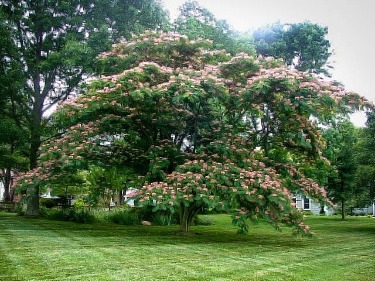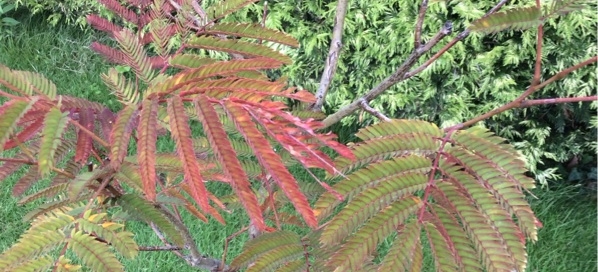The mimosa tree sometimes called the silk tree is a beautiful ornamental plant with feathery, fern-like leaves and fluffy pink flowers that are often compared to pom poms. Although this tree adds visual interest and vibrant color to the landscape, mimosa trees are notorious for dropping their leaves – even in the summer when they should be fully leafed out and flowering.
There are a few reasons why your mimosa tree may be losing its leaves during the summer months. Here is an overview of the most common causes, along with tips on how to help your mimosa tree maintain its foliage and flourish.
How Mimosa Trees Lose Their Leaves
Mimosa trees actually have a unique type of leaf called a bipinnately compound leaf. This means each leaf is made up of a central stem with smaller leaflets extending from it in a feather-like pattern. The petiole (or leaf stem) acts as a small hinge allowing each individual leaflet to droop or fold up in response to environmental conditions.
When temperatures rise and conditions turn dry, the hundreds of tiny leaflets on a mimosa tree are prone to wilt, droop, and eventually drop off. It’s a protective mechanism – by dropping some leaves, the tree reduces water loss through transpiration. But extensive leaf drop can leave your mimosa looking bare and struggling to survive.
Common Reasons for Summer Leaf Drop
If your mimosa tree looks like it’s prematurely losing its leaves in the middle of summer, there are a few likely culprits:
Insufficient Water
- Mimosa trees need to be watered regularly, especially during hot, dry periods. Drought stress and under watering will cause the leaves to turn yellow, wilt, and fall off.
- Make sure young trees get at least 1 inch of water per week, either from rainfall or supplemental watering. Mature trees need at least 2 inches.
- The ground beneath the tree should never be allowed to completely dry out.
Poor Drainage
- While mimosas need moisture, they do poorly in soggy, waterlogged soil.
- Standing water prevents the roots from getting the oxygen they need. It also makes the tree more vulnerable to fungal diseases.
- Improve drainage around the tree if you suspect wet soil. Consider creating a berm or swale to divert excess water away from the root zone.
Root Disturbance
- Root damage from digging, trenching, or soil compaction can interrupt the uptake of water and nutrients. This shocks the mimosa and causes leaf drop.
- Avoid driving vehicles or equipment over the root system. Don’t trench or disturb the soil within the tree’s dripline.
Extreme Heat
- Prolonged hot, dry weather tends to stress mimosa trees and cause moisture loss through the foliage. This leads to leaf wilt and drop.
- Provide shade and wind protection if possible. Mulch around the tree to cool the soil. Rely on supplemental watering during heat waves.
Pests or Diseases
- Spider mites, webworms, and other pests can sometimes attack the leaves of mimosa trees. Fungal issues like root rot are also possible.
- Check for signs of any disease or infestation. Apply appropriate organic treatments if needed.
Transplant Shock
- Newly transplanted trees often drop some leaves as they adjust to their new site. Make sure recently planted trees get extra water.
- Avoid transplanting in summer. Spring and fall are better times to relocate mimosas.
Normal Seasonal Leaf Drop
- Healthy mimosa trees will naturally shed older leaves in late summer/early fall as new growth emerges. Some leaf drop is normal at this time of year.
- As long as the leaf loss isn’t excessive or leaves are falling at the wrong time, it may not indicate a problem. Monitor to make sure new leaves grow in.
How to Stop Mimosa Trees From Dropping Leaves
Once you’ve diagnosed the cause of the leaf drop, you can take steps to help your mimosa recover and retain its feathery foliage:
- Water the tree thoroughly and regularly, especially during hot, dry spells. Provide a deep soaking at least once a week.
- Apply 2-3 inches of mulch around the base to retain soil moisture and reduce stress. Organic mulches like wood chips work well. Avoid volcano mulching.
- Fertilize mimosas annually in early spring using a well-balanced, slow-release formula. This encourages healthy growth.
- Prune out any dead or damaged branches which can divert energy away from leaf growth.
- Control lawn grasses and weeds which compete with the mimosa for water and nutrients.
- Monitor for pests like webworms and treat promptly if found. Neem oil works well for common insects.
- Improve drainage around mimosas sitting in wet soil. Consider adding a French drain system if needed.
- Avoid trenching or disturbing the soil within the dripline of the tree.
- Prevent damage to the trunk and avoid compaction in the root zone when mowing and weed whacking.
- Whitewash young, thin barked trees to prevent sunburn damage on hot, sunny days.
- Consider providing shade for vulnerable trees during periods of extreme heat.
When to Worry About Summer Leaf Drop
Moderate leaf drop on a mimosa tree during summer is normal and not necessarily a cause for concern. But if the leaf loss seems excessive and persists, it likely indicates a problem.
Contact a certified arborist if your mimosa tree shows these signs:
- Rapid leaflet drop leaving long, bare stems behind
- More than 60% defoliation, with sparse leaves remaining
- Widespread yellowing/browning and wilting of leaves
- Loss of leaves on entire branches or sections of the tree
- Leaves dropping very prematurely in early summer
- Lack of new growth after several weeks
- Visible signs of pests, disease, or damage
- Leaf loss coupled with thin, stunted growth
Sudden, severe leaf drop in summer could mean your mimosa tree is under serious stress and in decline. Diagnosing and correcting the cause quickly is important to restore the tree’s health. With prompt care and improved growing conditions, new leaves should flush out again in 4 to 6 weeks.
Long Term Care for Healthy Mimosa Trees
Taking good care of your mimosa tree from the start is key to preventing summer leaf drop issues. Here are some general tips:
- Select a suitable planting site with well-draining soil and plenty of sun. Avoid soggy spots.
- Water 1-2 times per week for the first two years after planting, then weekly during dry spells.
- Apply a 2-4 inch layer of organic mulch around the base every spring. Pull it away from the trunk.
- Fertilize with a 10-10-10 balanced fertilizer or a mimosa-specific formula in early spring when new growth starts.
- Prune out any dead, damaged, or crossing branches in late winter. Avoid heavy pruning which stresses trees.
- Monitor regularly for pests like webworms and diseases. Take prompt corrective action.
- Avoid soil compaction and excavation within the tree’s dripline.
- Consider professional support systems like cabling for older, structurally weak trees.
With the right care and growing conditions, most mimosa trees can recover from minor to moderate summer leaf drop. But severe, rapid defoliation indicates an underlying problem that requires diagnosis and treatment to restore the tree’s health. Contact a certified arborist if you notice extensive mid-summer leaf loss on your mimosa.
Growth Rate and Mature Height
The Mimosa Tree is a small to medium sized ornamental tree. It is also exceptionally fast-growing. The tree will quickly grow to be 20 to 25 feet tall and 10 to 20 feet wide. This tree grows very quickly. In a growing season, the Mimosa Tree can often gain up to 5 feet!
The Best Places to Plant the Mimosa Tree
 The Mimosa Tree, which originated in southwestern and eastern Asia, prefers the warmer climates. The tree is now commonly found throughout many regions of the world, and it can withstand brief cold spells.
The Mimosa Tree, which originated in southwestern and eastern Asia, prefers the warmer climates. The tree is now commonly found throughout many regions of the world, and it can withstand brief cold spells.
The Mimosa Tree grows best in USDA Hardiness Zones 6 through 10 in the United States. It likes the subtropical to tropical climates of many lower latitudes. Plant the mimosa tree where it will get full sun. However, some partial shade can help the tree keep its water, especially in the driest parts of the southwest. The Mimosa Tree is best suited as an accent plant, where its ornamental beauty will not be lost. For many gardeners, this may mean a center-garden or center-yard spot. The Mimosa Tree can also be used to line driveways or entryways, and because of its uniform shape, it looks good with other trees of the same species.
Mimosa Trees prefer the moist, well-drained soil typical of loam. With regard to pH, the tree enjoys slightly acidic soil. Despite these preferences, the Mimosa Tree readily adapts to various soil conditions. Water is not as much of a concern for the Mimosa Tree. In fact, short dry spells will not harm this tree since it is drought-resistant. The Mimosa, like most flowering trees, needs at least an inch of water a week, which can come from rain or irrigation. If the area where the tree is planted is prone to severe droughts, you might want to buy an irrigation system that will help you control the flow of water and get it to the Mimosa during those really hot, long-lasting droughts.
The Mimosa Tree is a beautiful ornamental plant. When considering planting locations, look for one where its beauty will shimmer!.
Why Your Citrus Trees Are Losing Leaves And How To Fix It
Why do mimosa trees die?
The sensitivity of mimosa trees to Fusarium wilt, a deadly disease that often results in the tree’s full mortality, is another serious issue. Early to midsummer is when the leaves of diseased mimosa trees begin to yellow and droop, ultimately causing the tree to die.
How long do mimosa trees last?
The average lifespan of mimosa trees is only 30 years. Additionally, the trunk and branches are weak and brittle and easily break in strong winds. Albizia julibrissin has the common name mimosa due to the resemblance to mimosa plant leaves. Other names for mimosa trees include the Persian silk tree, pink siris, pink silk tree, and Lenkoran acacia.
When do mimosa trees bloom?
The mimosa trees bloom in the depths of summer when it is adorned by lovely flowers. They start to bloom in early May and go on till July. While they can withstand cold weather and less sunlight, their foliage becomes deep green in the sunshine and warm weather conditions. Where do mimosa trees grow?
How do you know if a mimosa tree is dying?
Branch dieback is a serious sign that a mimosa tree is dying. This is when the branches of the tree start to die back, and it can eventually lead to the entire tree dying. Root rot. Root rot is a fungal disease that can kill mimosa trees. It is caused by a fungus that attacks the roots of the tree, and it can eventually lead to the tree’s death.
- The Ultimate Guide to Growing Strawberries in Raised Beds - August 8, 2025
- No-Dig Garden Beds: The Easiest Way to Grow a Beautiful Garden - August 6, 2025
- How to Protect and Preserve Wood for Raised Garden Beds - August 6, 2025

